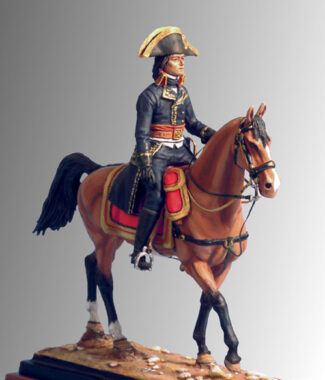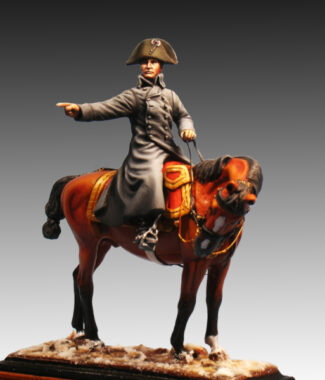You must be logged in to post a review.
Napoleon First Consul – 1800
€65.00
Figure to assemble and paint
Ref.: 08 – RE
Weight: 250 grs.
Material: White Metal
Number of Pieces: 12
Historical Review:
After the coup d’état of 1799 that brought down the bourgeois republic, France became a consulate whose main figure was General Napoleon Bonaparte. The Consulate was a collegiate government composed of the three consuls and four assemblies (Tribune, Senate, Council of State and Legislative Corps). In reality, however, all policy depended on Napoleon; the other two consuls became his mere advisers. Hence, in this period, France reverted to a form of enlightened despotism, albeit with a greater presence of the military establishment that had emerged from the Revolution.
Its political system took the form of a new Constitution, that of the year VIII (1800), which was approved by the people by more than three million votes and promulgated on 15 December. The Constitution was accepted by the people not only because it ushered in an era of order and peace, but above all because it pleased Napoleon himself, who had become not just the first consul, but the country’s first hope. It is also true that the vote was taken by open ballot, which helped to form that majority of votes.
The job of the consuls was therefore a complicated one, as they had to try to satisfy a lot of people. They had to be careful with hoarders, landlords, Jacobins and even intellectuals, who exercised a considerable moral influence on public opinion.
As part of his legislative function, and in order to bring about a social reconstruction that would eliminate disorder, one of the most important works carried out by the First Consul and the Council of State was the drafting of the Civil Code in 1800, completed in 1804 and renamed the Napoleonic Code in 1807. It was the code of the new bourgeois society, which influenced the social development of France and Europe. It incorporated the Roman legal tradition and the innovations introduced into civil law by the Revolution (personal freedom, freedom of conscience and professional freedom, equality before the law, equality before the law, etc.).
Napoleon maintained internal order and consolidated his authority through secret political police and, above all, through a strong centralizing and restrictive policy, which provoked harsh criticism from the opposition. The public administration was organized more rigidly than in the France of absolutism. The departments (provinces), created by the Constituent Assembly, were governed by prefects (governors), sub-prefects and trustees who were appointed by the First Consul and only before him did they have to answer directly for their actions. The administrative bodies of the municipalities and provinces exercised only advisory functions. Freedom of the press was guaranteed but curtailed. Newspapers could not be instruments in the hands of the enemies of the Republic. Only 13 were allowed to be sold in all of France.
In the economic field, Napoleon, although he remained faithful to the doctrines of economic liberalism, as an enlightened despot followed a protectionist policy. He encouraged agricultural development, concerned himself with industrial progress and the road network, and improved domestic trade. He solved the financial chaos with a policy of order and economy in the Public Treasury and in taxes. He prohibited tax exemptions based on birth, social position or special agreements, which made it possible for the first time in ten years for the government to actually collect the taxes that were set. Expenditures were also ordered, the corps of officials necessary for the timely collection of taxes were created, and accounting methods were perfected. And to organize finances, the consular government founded the Bank of France in 1800, shortly after the Court of Accounts and the Court of Cassation were organized, and a new healthy currency and public credit were established.
Napoleon was successful in his religious policy: he achieved the Concordat of 1801 with the Holy See, which put an end to the religious persecutions unleashed by the Revolution, attempted to integrate Catholics into the New France, gained some control over the appointments of the Catholic hierarchy, and improved the nation’s image in Europe. In the same year, his military victory at Marengo brought peace with the Austrian Empire and French rule over most of Italy. With the United Kingdom, the First Consul signed the Peace of Amiens in March 1802, by which France returned Egypt to Turkey and retained its continental conquests, making it the land power of Europe.
The figure shows the uniform in which Napoleon was depicted as First Consul in later paintings by artists such as Ingres and Antoine-Jean Gros. He rides a splendid Arabian horse.








Reviews
There are no reviews yet.